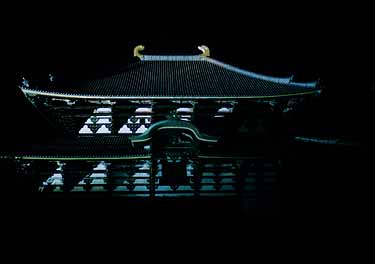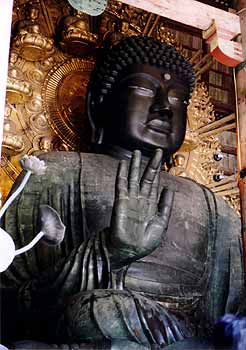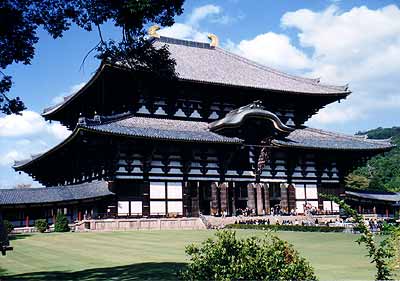
 |
| Main Page |
| Photo Galleries |
| Writing |
| Aikido |
| Zen |
| Peeps |
| Links |
| Contact |
 |
 |
 |
|
Todai-ji Temple
|
||
 Looming
above the close cropped field that surrounds it, the Daibutsu-den
of Todai-ji Temple soars above the visitor in a way that is uncharacteristic
of many Japanese temples. The impression, however, is no coincidence;
the great hall of Todai-ji is the largest wooden structure in the world,
standing 159.89ft (48.74m) tall at a width of 187.03ft (57.01m).
Looming
above the close cropped field that surrounds it, the Daibutsu-den
of Todai-ji Temple soars above the visitor in a way that is uncharacteristic
of many Japanese temples. The impression, however, is no coincidence;
the great hall of Todai-ji is the largest wooden structure in the world,
standing 159.89ft (48.74m) tall at a width of 187.03ft (57.01m).
Whether seen during the day, with the thronging crowds flocking to see the great Buddha which the hall contains, or at night, when the massive structure is illuminated in a ghostly light, Todai-ji temple succeeds in impressing the visitor with its sheer immensity.
Built as the culmination of efforts to make Buddhism the
national religion of Japan, Todai-ji was  constructed
in the 743 to act as the head temple for the relatively newfound faith
at the behest of Emperor Shomu. Though the existing structure remains
the largest of its kind in the world, it is, in fact, a 1692 reconstruction
which is only two-thirds the size of the original.
constructed
in the 743 to act as the head temple for the relatively newfound faith
at the behest of Emperor Shomu. Though the existing structure remains
the largest of its kind in the world, it is, in fact, a 1692 reconstruction
which is only two-thirds the size of the original.
A building of this size, however, immediately begs the question of just what it contains, and in this case the contents are no less surprising than the vessel. The Daibutsu-den houses the renowned statue of the Vairocana Buddha, which stands at an impressive 48.91ft (14.98m) tall and weighs over 380 tonnes. It is one of the world's largest gilded bronze Buddhas, and is most certainly the largest in Japan.
The combination of records which Todai-ji holds makes it
a strange example among the normally sedate and understated temples of
this country. Compared with the calm rock gardens of Ryoan-ji, the quiet
strolling gardens of Ginkaku-ji and the densely treed precincts of Nanzen-ji,
Todai-ji seems to reflect a very Chinese influence that was a part of
early Buddhism in Japan. It also symbolizes the early ties that the religion
had with the state, as everything in the temple was clearly built to impress;
the biggest Buddha in the biggest hall, with the biggest  collection
of treasures and reached only by entering through the country's biggest
San-mon gate. In many ways, Todai-ji represents the last of the temples
to be built before the Imperial Court came to realize the sheer strength
and influence of the religious order they had helped to introduce.
collection
of treasures and reached only by entering through the country's biggest
San-mon gate. In many ways, Todai-ji represents the last of the temples
to be built before the Imperial Court came to realize the sheer strength
and influence of the religious order they had helped to introduce.
The Emporer who had ordered the construction of Todai-ji had, at one point, described himself as Buddha's 'servant'; a statement which he later equivocated because of its implications regarding his own authority. Though Buddhism was enthusiastically welcomed and promoted by the Court at this time, there was also the understanding that Imperial authority relied upon the continuity of Japan's native religion - Shinto - and the Emperor's role as the living Godhead of that religion.
All of this makes Todai-ji an incredibly interesting place to visit. It is a shining product of a time when Buddhism enjoyed the full favour of the state, and as such is an interesting contrast to temples such as Kyoto's Enryaku-ji, most of whose original 3,000 temple buildings were put to the torch by the government in order to trim its influence.